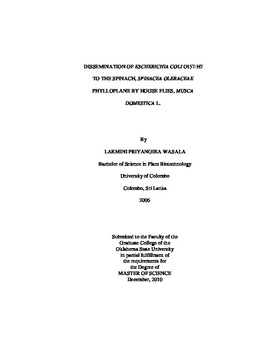| dc.contributor.author | Wasala, Lakmini Priyangika | |
| dc.date.accessioned | 2014-04-15T21:16:58Z | |
| dc.date.available | 2014-04-15T21:16:58Z | |
| dc.date.issued | 2010-12-01 | |
| dc.identifier.uri | https://hdl.handle.net/11244/9020 | |
| dc.description.abstract | Insects may be involved in the dissemination of human pathogens to fresh produce. This study aimed to determine if E. coli O157:H7 could colonize the spinach phylloplane via regurgitation spots deposited by house flies after exposure to E. coli O157:H7 acquisition sources. Attachment and colonization of E. coli O157:H7 on the external body surfaces of the house flies was also studied. Flies were exposed to different acquisition sources with and without E. coli O157:H7. Exposed flies were transferred to spinach plants and the regurgitation spots on days 0, 4 and 8 were analyzed by relative quantitative PCR. Also bacteria were spotted onto spinach leaves subjected to relative qPCR to understand the fate of the E. coli O157:H7 without the insect involvement on the phylloplane from 0-12 days post inoculation. Exposed fly legs and heads were dissected and E. coli O157:H7 were enumerated by microbiological methods from 0-13 days post exposure. Mouthparts and legs of bacteria-exposed flies were examined by scanning electron microscopy. The relative qPCR of the regurgitation spots showed that the E. coli O157:H7 DNA concentration increased on day 4 which suggested that the bacteria multiplied within the regurgitation spots when flies acquired the bacteria from inoculated manure. The relative qPCR of the artificial spotting did not show any significant change in the E. coli O157:H7 DNA levels on the phylloplane. E. coli O157:H7 persisted on the fly external body surfaces for 13 days and a colonization period was suggested from days 2-6. Overall the research data suggested that fly regurgitation is an important mode of human pathogen dissemination under laboratory conditions. Regurgitant may be a potential nutrition source for the bacteria. Body hairs and pseudotracheae may be potential niches for the bacteria to survive until they reach a more suitable environment. These data show the potential of house flies to contaminate spinach under laboratory conditions. Future studies will be aimed on to study the bacterial survival after regurgitation under field conditions. | |
| dc.format | application/pdf | |
| dc.language | en_US | |
| dc.publisher | Oklahoma State University | |
| dc.rights | Copyright is held by the author who has granted the Oklahoma State University Library the non-exclusive right to share this material in its institutional repository. Contact Digital Library Services at lib-dls@okstate.edu or 405-744-9161 for the permission policy on the use, reproduction or distribution of this material. | |
| dc.title | Dissemination of Escherichia coli O157:h7 to the Spinach, Spinacea oleraceae Phylloplane by House Flies, Musca domestica L. | |
| dc.type | text | |
| osu.filename | Wasala_okstate_0664M_11143.pdf | |
| osu.college | Agricultural Sciences and Natural Resources | |
| osu.accesstype | Open Access | |
| dc.description.department | Department of Entomology and Plant Pathology | |
| dc.type.genre | Thesis | |
